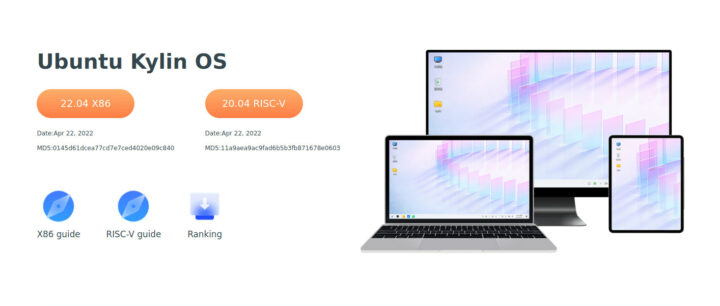China-developed Ubuntu Kylin 20.04 is now supporting RISC-V architecture with an image for HiFive Unmatched mini-ITX motherboard, and work will be done on an unnamed Starfive SBC that should be the VisionFive board with a GPUless JH7100 dual-core RISC-V SoC or an upgraded version with JH7110 SoC featuring an Imagination IMG BXE-4-32 GPU.
You may have read recent reports about China asking government entities, including state-owned enterprises (SOE), to replace foreign hardware and software within a two-year period. So that means avoiding systems based on Intel and AMD processors, so working on RISC-V open architecture makes perfect sense, since over time, Chinese manufacturers should be able to make RISC-V SoCs and PCs based on those processors, albeit probably not within the next two years at any significant scale.
 Ubuntu Kylin 20.04 RISC-V, as well as the newly released Ubuntu Kylin 22.04 x86, can be found on the English download page on the Ubuntu Kylin website. The RISC-V image is now only available for the HiFive Unmatched mini-ITX board with SiFive FU740 quad-core 64-bit U74 RISC-V processor, 16GB RAM, NVMe storage, and supporting discrete graphics cards through a PCIe slot. They did not do that from scratch since Ubuntu RISC-V images for HiFive boards have been available since last year.
Ubuntu Kylin 20.04 RISC-V, as well as the newly released Ubuntu Kylin 22.04 x86, can be found on the English download page on the Ubuntu Kylin website. The RISC-V image is now only available for the HiFive Unmatched mini-ITX board with SiFive FU740 quad-core 64-bit U74 RISC-V processor, 16GB RAM, NVMe storage, and supporting discrete graphics cards through a PCIe slot. They did not do that from scratch since Ubuntu RISC-V images for HiFive boards have been available since last year.
Some installation instructions can be found in a PDF in English. The announcement explains there’s still much work to be done to use RISC-V as an x86 replacement, and there are currently over 20 self-developed packages. The image relies on a Linux 5.11 kernel and features the Ephiphany 3.36 browser and Calligra 3.10 office suite, as well as UKUI 3.0 desktop environment.
Initial Ubuntu Kylin support for the StarFive SBC will be added as part of the “Summer of Open Source (OSPP)” activity for college students with the project description, translated from Chinese to English, reading:
This project plans to make a RISC-V version of the Ubuntu Kylin system image based on the StarFive development board, and complete a certain degree of startup on the basis of the basic image. Optimization and adaptation of power management.
So there are not putting huge resources behind this development, but at least somebody will be working on it between July 1st and September 30th.
Via The Register

Jean-Luc started CNX Software in 2010 as a part-time endeavor, before quitting his job as a software engineering manager, and starting to write daily news, and reviews full time later in 2011.
Support CNX Software! Donate via cryptocurrencies, become a Patron on Patreon, or purchase goods on Amazon or Aliexpress




